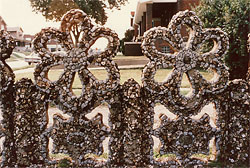 Back | Next
Back | Next

Topic
6
Slide
Show:
Built
Environment
Powerpoint
presentation (in Adobe Presenter format) Click "Notes" for author's description of slides. It is suggested that you set the main slide controller (in the bar under the slide) to ">" / stop, instead of "||" and advance the slides manually using the ">|" and "|<" buttons.
People
cannot plan or build the world without creating or changing themselves.
The built environment is the physical counterpart of the social
community. It reflects the neighborhood's history, culture, spiritual
beliefs, and social organization. This section uses The Hill neighborhood
in St. Louis to illustrate Kevin Lynch's categories of "edge",
"path", "node", "landmark", and "district"
and also the concept of "sacred space".
Readings:
Kevin Lynch, A
Theory of Good City Form (Cambridge: The MIT Press, 1981),
" Sense", pp. 131-150.
Reading
#1 (pdf)
Mirceau
Eliade, The Sacred and the Profane (New York: Harcourt,
Brace and Company, 1959), "Sacred Space and Making the World
Sacred", pp. 20-65.
Reading
#2 (pdf)
Louis
Colombo, "Neighborhood Place and Community, History, Social
Capital, Religion, and Meaning in The Hill District of Saint Louis,
Missouri"
Reading
#9 (pdf)
Levi
Romero, "La Nueva Resolana", in New Mexico, May 2001,
pp. 26-31.
Reading
#15 (pdf)
NOTE:
If you have difficulty in opening your readings, you may need to
download Adobe
Acrobat Reader.
This is a free download and simple installation. Please follow the
instructions at the official Adobe
website.
|
|

Selected
Readings
(pdf)
Built Environment
Subtopics inside:
Meaning
Physical elements / identity
Physical environment and culture
Urban Renewal / Loss of Home and Damage to Identity
|


